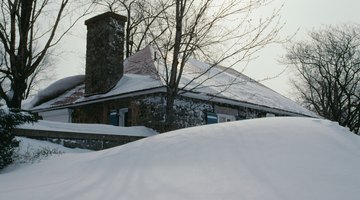What Can I Build to Stop Snow From Drifting Along the Side of My House?
Snow drifts block driveways, walkways and can make it difficult to open doors. They can also damaged flowerbeds and cause soil erosion when they melt in spring. Snowdrifts, either against the side of your house or other yard area, are controlled by barriers.

Barriers are constructed from a wide range of materials that are practical and aesthetically pleasing.
Planning
Before building a barrier to prevent the build-up of snow drifts, such barriers are typically called a snow fence, you must assess the area where the snow drifts. Determine the direction from which wind usually moves the snow. This is fairly simple to determine, even when it isn't snowing. A wind sock will help you view the direction of the prevailing winds in your area. Plan on placing a barrier perpendicular to the wind direction.
Placement
The most economic way to create a snow barrier is to use one, tall barrier. However, this is not always the most favorable option. You may not wish to have an 11-foot fence along the side of your house. In situations like this you can create a series of oblique, staggered barriers. These barriers are spaces several feet apart with edges that overlap. This method creates a snow break resulting in a series of small drifts.
Design
Barrier sides should extend at a 30-degree angle from the prevailing wind direction. Leave a gap, about 10 percent of the snow fence's height, at the bottom of the barrier. This allows some wind circulation and prevents the barrier from breaking under the weight of snow and wind stress. Engineers use a formula to determine the optimum snow fence height but, typically, an eight-foot structure will hold back snow in areas with high wind and heavy snowfall. Generally, the closer you place the barrier to the area you want to protect, the more effective the barrier.
Barriers
Barriers are constructed of porous materials, this allows wind to pass through but keeps snow from penetrating the structure. Mesh, either plastic or wire, are effective snow barriers as are wood plank fences. As an alternative to building a fence, you can grow one. Shrubs and trees provide windscreens, privacy screen and also act as protection against snow drifts. A stand of columnar evergreens, deciduous trees and even native prairie grass can block wind and prevent blowing snow. Use the same design and planning techniques used for other barriers to determine wind speed and snow height. Choose vegetative barriers that grow to heights suitable for snow and wind blockage. Stagger plantings in the same manner as you would other barriers.
The Drip Cap
- Snow drifts block driveways, walkways and can make it difficult to open doors.
- Snowdrifts, either against the side of your house or other yard area, are controlled by barriers.
- Determine the direction from which wind usually moves the snow.
- In situations like this you can create a series of oblique, staggered barriers.
- Engineers use a formula to determine the optimum snow fence height but, typically, an eight-foot structure will hold back snow in areas with high wind and heavy snowfall.
- Shrubs and trees provide windscreens, privacy screen and also act as protection against snow drifts.
Writer Bio
Catherine Duffy's writing can be found on gardening blogs, tech sites and business blogs. Although these topics seem quite different, they have one area in common: systems and design. Duffy makes systems and design (as they pertains to plants, supply chains or software) entertaining and welcoming to general readers.
Photo Credits
- Photos.com/Photos.com/Getty Images
- Photos.com/Photos.com/Getty Images
More Articles



